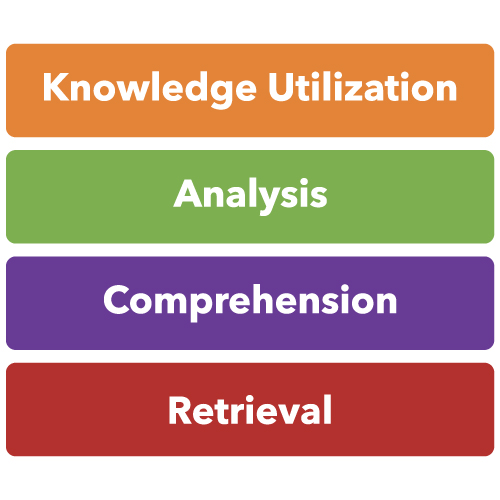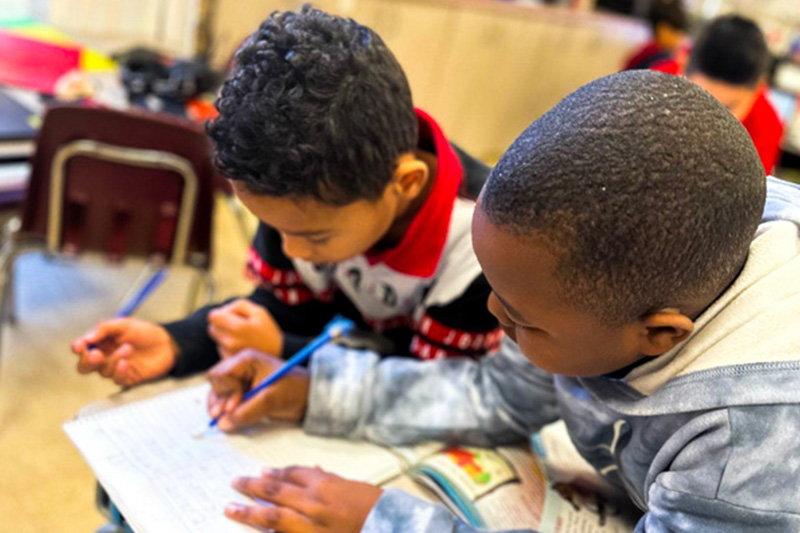
Students engage deeply in team-based, rigorous academic tasks.
Student Engagement Declined in Recent Years
Education leaders are working to lead their schools and districts to deeper and more authentic student engagement, knowing that students who are more motivated to learn will achieve better outcomes. However, school officials report that after COVID, many of their students became more passive, have a lesser sense of social belonging, and feel disengaged from their learning. The EdWeek Research Center surveyed students and teachers at the beginning of the 2020-2021 school year and found that student motivation and morale were significantly lower than in previous years. Student engagement is critical to learning and increasing student achievement, but it remains a challenge in most K-12 schools today. See figure 1.
Student Motivation and Morale in the 2020-21 School Year
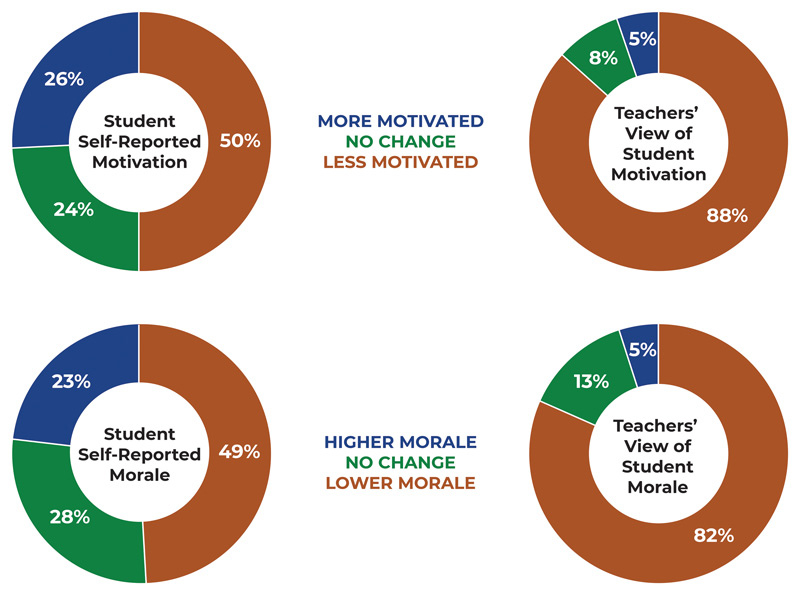
Figure 1. Students self-reported less motivation (50%) and lower morale (49%) as compared to their motivation and morale in the 2019-2020 school year. An even larger majority of teachers perceive less student motivation (88%) and lower student morale (82%). Data derived from the EdWeek Research Center (2021).
With an ever-changing classroom landscape, it’s evident that leaders will need to find new ways to bring their schools and districts beyond traditional engagement strategies. By emphasizing academic rigor, educators can transform classrooms and create a culture where students are motivated to take on a greater role in their learning.
Understanding how to lead instructional systems that create deep student engagement requires first understanding the definition of student engagement, the benefits, the different types of engagement, what it looks like in the classroom, and the psychology of engagement.
Why Is Student Engagement So Important?
According to educational neuroscience expert Dr. David Sousa (2016), student engagement can be defined as “the amount of attention, interest, curiosity, and positive emotional connections that students have when they are learning, whether in the classroom or on their own” (p. 17).
Dr. Sousa notes that engaged students:
- Have more motivation to participate in class
- Enjoy achieving their learning goals
- Are more likely to persist through challenges in learning
- Feel intrinsically motivated to gain new and deeper understanding
One of the main reasons why student engagement is so important is because the associated skills and habits—motivation, joy of learning, persistence, curiosity—set students up to thrive in college and their careers.
The importance of student engagement cannot be underestimated—engagement affects student achievement, students’ futures, and it can potentially help to close learning gaps.
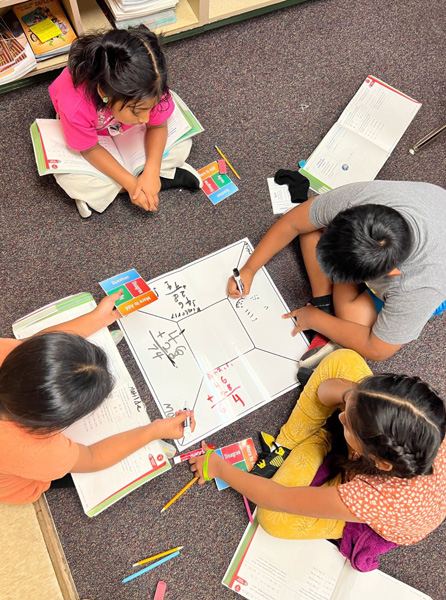
Students use a Summarizing Thinking Mat and Agree/Disagree Cards from the Model of Instruction for Deeper Learning during a high engagement team task in math.
How Does Engagement Impact Student Achievement?
The correlation between high student engagement and improved academic outcomes has a strong research history (Dyer, 2015). Meta-analyses indicate that student engagement is associated with overall academic achievement (Lei et al., 2018), while other studies show strong relationships between student engagement and achievement in mathematics (Maamin et al., 2022) and reading (Mete, 2020).
A Gallup study, which involved 128 schools and more than 110,000 students, found that student engagement had a significant positive relationship with students’ academic achievement progress (growth) in math, reading, and all subjects combined (Reckmeyer, 2019). See figure 2.
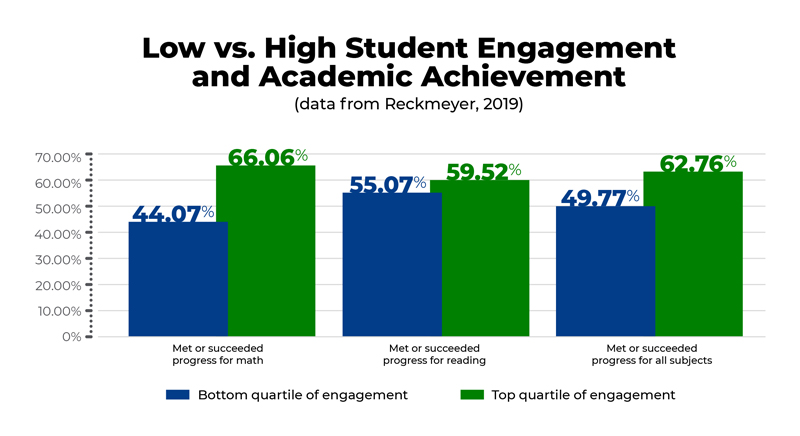
Figure 2. The effect of low (bottom quartile) vs high (top quartile) student engagement was especially impactful in math—students with higher engagement had 21.99% higher achievement compared to students with low engagement. Achievement was 4.45% higher in reading and 12.99% higher in all subjects for engaged students. Data derived from Gallup poll (Reckmeyer, 2019).
How Does Engagement Impact Students’ Futures?
As discussed above, student engagement encourages skills and habits that give students a better chance of success once they leave school.
In fact, a longitudinal study of Australian students ages 9-15 found that 20 years later, those who had higher childhood school engagement were more likely to achieve a higher adult occupational status than those who were less engaged in school (Abbott-Chapman et al., 2014).
How Can Engagement Help Close Learning Gaps?
In the aftermath of the pandemic, the focus on engagement becomes even more critical. With potential learning gaps and the varied impact of remote learning experiences, engaging students through interactive and participatory teaching methods can be pivotal in addressing these gaps and promoting academic success. Passive learning methods, such as simply listening to the teacher and copying information without actively engaging in the material, may not effectively stimulate the brain to absorb and retain knowledge.
Engagement in learning involves active participation, critical thinking, problem-solving, and application of knowledge. Leaders can ensure that learning environments are set up for students to be actively involved in their learning process and deepening their knowledge and skills. This learning environment can be achieved through interactive discussions, collaborative learning, and other methods that require students to apply what they’ve learned. When looking for signs of deep student engagement, leaders should see all students engaged in critical thinking, verbalizing their thinking through debates and discussions, demonstrating curiosity, and taking ownership of their own learning.
Addressing learning loss requires a multifaceted approach that involves not only catching up on missed content but also rekindling the joy of learning. It’s about creating an environment that motivates students to actively explore, question, and learn.
The Brookings Institute recommends that schools focus on the instructional core in order to emerge stronger as they move beyond the pandemic (Vegas & Winthrop, 2020). When students are engaged, they are more likely to excel in Tier 1 instruction and less likely to need academic interventions.
The Economic Policy Institute also recommends more personalized instruction to help students catch up—especially for those students who have been disengaged in recent years (García & Weiss, 2020).
One of the most effective ways to personalize learning is to use student-driven engagement strategies, as we will explore in the next section.
What Do Different Types of Student Engagement Look Like?
Student engagement looks different depending on if the engagement is coming from the teacher or from the students and the academic tasks.
Most leaders aim to increase teacher-driven engagement. Many teaching programs encourage teacher-driven methods such as building strong teacher-student relationships, delivering high-energy lectures, and using interactive games. Naturally charismatic teachers often excel with these methods. When a teacher is struggling with cultivating an engaging environment, traditional professional learning is focused on creating the master teacher, when the focus should be on creating master students— creating a student-driven environment.
Student-driven engagement can be much more effective than teacher-driven engagement. Student-driven engagement methods focus on creating challenging learning tasks and giving students the roles, responsibilities, and collaborative structures to engage in these tasks with their peers. Engagement comes from peer interactions and the challenge of the tasks, rather than primarily from interactions with the teacher.
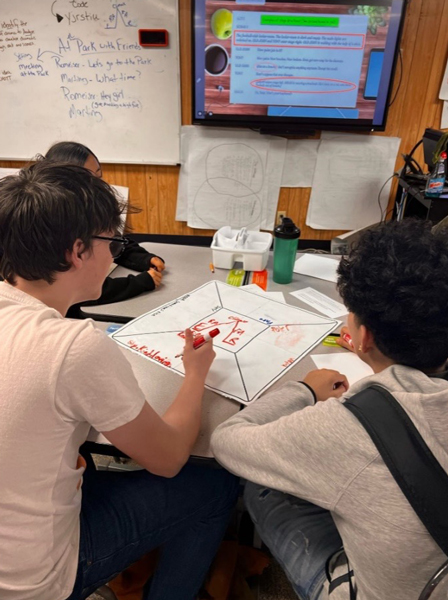
Student-driven engagement comes to life with a Summarizing Thinking Mat from the Model of Instruction for Deeper Learning
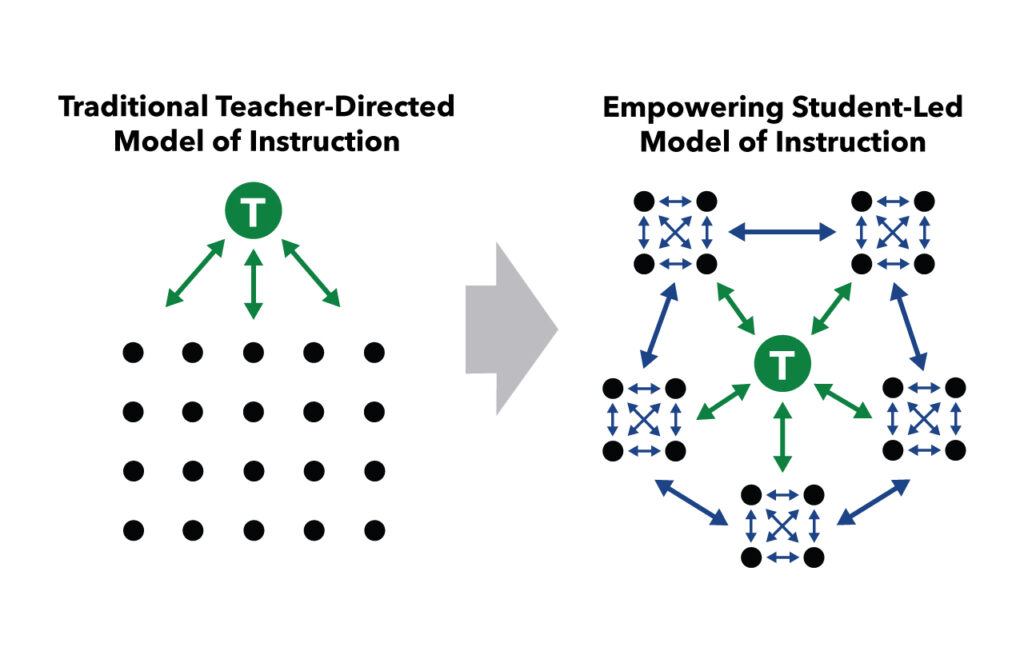 The important difference is that teacher-driven strategies are highly dependent on a teacher’s experience level and personality, while student-driven engagement strategies can be taught through professional learning and coaching.
The important difference is that teacher-driven strategies are highly dependent on a teacher’s experience level and personality, while student-driven engagement strategies can be taught through professional learning and coaching.
By leading the shift away from the traditional, teacher-directed model, leaders can empower teachers to gradually shift more autonomy to students within Tier 1 instruction. Students take on meaningful roles and responsibilities within their teams, building their academic confidence and ownership. Educators cultivate student agency, which is the ability of students to self-direct their own learning.
School leaders have reported that even their first-year, inexperienced teachers achieved the same positive effects as veteran teachers when using student-driven methods (Becoming a School Where All Students Thrive, 2019).
In the table below are a few examples of what classrooms can look like depending on the role of the teacher and students and the level of academic challenge.
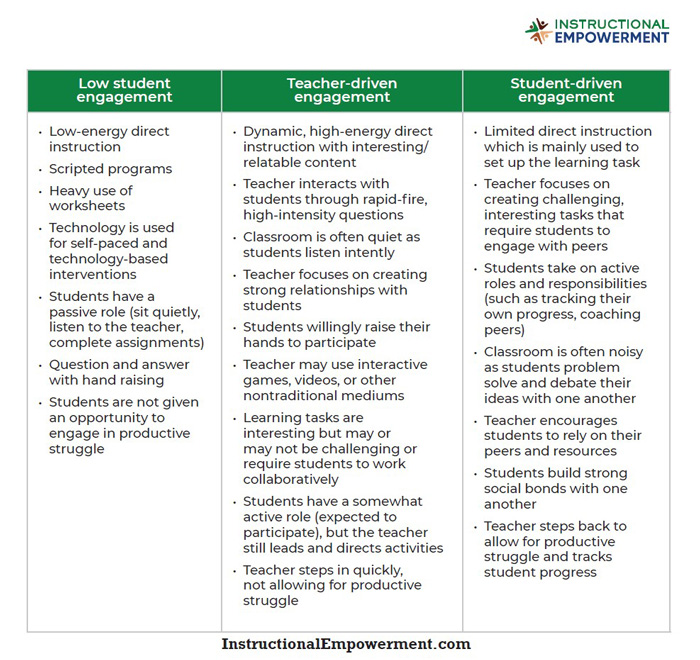
The Psychology Behind Student Engagement: Flow and Productive Struggle
The epitome of student engagement is when students experience what is known in psychological research as flow: “joy, creativity, the process of total involvement with life” (Csikszentmihalyi, 2008, p. xi).
According to Mihaly Csikszentmihalyi—the psychologist who discovered the concept of flow and spent decades studying how people experience it—the combination of both high challenge and high skill is what creates flow. Csikszentmihalyi wrote:
“The best moments in our lives are not the passive, receptive, relaxing times…The best moments usually occur if a person’s body or mind is stretched to its limits in a voluntary effort to accomplish something difficult and worthwhile” (2008, p. 3).
Flow is similar to the concept of productive struggle, where teachers create structures for students to actively discover new and deeper understandings instead of passively giving students information through direct instruction. The definition of productive struggle is:
“Students grapple with and solve a question or problem that is just beyond their current level of understanding and that requires them to examine multiple avenues of thought. Students wrestle with ideas yet persevere and come up with solutions themselves” (Toth & Sousa, 2019, p. 12).
Like flow, productive struggle relies on a combination of challenge (a rigorous academic task) and skill (which is developed when students have full autonomy to take on active roles and responsibilities). See figure 3.
Both flow and productive struggle make clear why student engagement is important in the classroom. When students experience the joy of accomplishing a worthy academic challenge, they are motivated to work harder. As students continue to work harder, they build persistence, critical reasoning, and the ability to apply their learning.
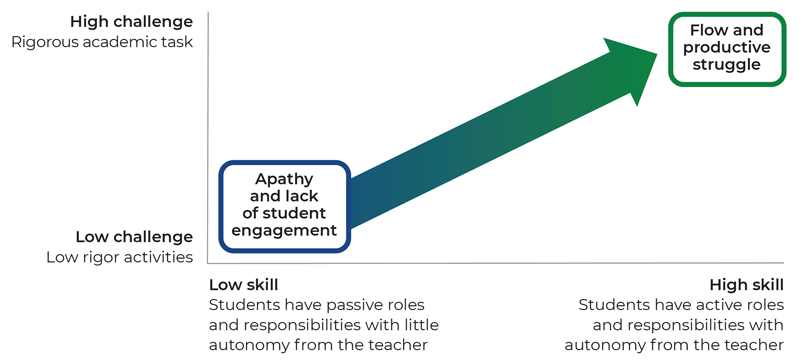
Figure 3. The conditions that create flow and productive struggle lead to a learning environment where students are highly engaged. Based in part on Csikszentmihalyi’s flow research and diagram (1997), along with our original research and thought leadership incorporated.
Subscribe for curated education insights delivered every two weeks.
6 Student-Driven Strategies to Improve Engagement and Motivation
Taking into account the research on why student engagement is important and how to cultivate it, the following strategies can help leaders guide their schools and districts to improve engagement and motivation.
1. Create schoolwide conditions for students to engage in standards-based learning
Leaders should ensure that schools create environments where all students engage in rigorous standards-based learning. It is not just about having structures in place but about fostering the right conditions that support students in engaging effectively with the curriculum. Setting up these conditions goes beyond establishing physical structures. It involves fostering a culture within the school and classroom that values and prioritizes student well-being, engagement, and active participation in the learning process. When these conditions are met, students are better equipped to engage in rigorous standards-based learning.
Example: Below are examples of the conditions that are key to deeper student engagement and learning.
Safe and Supportive Environments: Students need to feel safe and secure within their school and classroom environments. When students feel safe, they are more likely to engage actively in learning. Safety encompasses physical safety as well as emotional and psychological safety, creating an atmosphere where students feel comfortable to take risks and express their thoughts and ideas without fear of judgment.
Conducive Learning Environments: Classrooms need to be set up in a way that promotes learning. This includes not only physical arrangements but also the overall atmosphere within the classroom. A conducive learning environment encourages active participation, critical thinking, and collaboration.
Environments Supporting Student Self-Regulation: Empowering students to self-regulate their learning is crucial. This involves teaching them skills to manage their own behaviors, emotions, and learning strategies. When students have the tools to regulate their own learning, they can better engage with academic tasks and make meaningful progress.
Environments Supporting Empowerment: An empowering environment encourages students to take ownership of their learning. Students feel that their thoughts and contributions are valued and that they have a role to play in their own education. Empowering students can lead to increased motivation and engagement with the curriculum.
2. Ensure more time is focused on collaborative active learning
Leaders can support teachers to “right size” lessons, so students have more time for collaborative active learning with their peers. Students do not need to have everything explained to them up front—in fact, students learn more when they have the autonomy to make academic discoveries on their own. If productive struggle turns into unproductive struggle because students didn’t have enough foundational information, teachers can always fill in knowledge gaps and correct misunderstandings as they go.
Example:
Teacher A (passive learning) gives a lecture explaining how and why each state named its capital and then asks students to create a chart to prove they understood the factors involved in becoming a state capital.
Teacher B (collaborative active learning) gives an abbreviated lecture (perhaps only explaining a few new vocabulary words) and then writes an open-ended question on the board (such as “What factors do you think a city needs in order to become a capital?”). Students investigate using texts and other resources provided by the teacher, formulate their reasoning, and explain and debate with peers to discover the answers on their own.
Student tools, protocols, and teacher resources to support collaborative active learning can be found in the Model of Instruction for Deeper Learning TM.
For more examples of how a traditional teacher-directed instruction task can be transformed into a high engagement, collaborative student-led learning task, see:
3. Support teachers in giving students real roles and responsibilities
Leaders can visit classrooms to see whether the classroom structures for student autonomy are in place so that students can become more active, engaged participants in their own learning. In most classrooms, when students are working independently, the teacher’s role is to support students by checking student work, answering students’ questions, and offering coaching and feedback. Instead, leaders can support teachers to gradually empower students to self-track their learning progress, coach their peers, and turn to each other and their resources to find answers to their questions. Students quickly become adept at personalizing the learning to one another’s needs. By relying on teammates when in need of support, and only going to the teacher as a last resort, students engage in productive struggle and deepen their learning.
Example:
Teachers can organize students into teams and give each student a role card describing their responsibilities to the team. For example, one student might be the team facilitator, who takes responsibility for supporting all team members to participate equally. Teachers might provide a list of prompting questions for the team facilitator to use, such as “Where in the text do you see evidence for your idea?” Students can practice these roles in their groups. In the initial practice rounds, using non-academic topics is fine to ensure students feel comfortable in their new roles and responsibilities before moving on to rigorous academic tasks. Further guidance on roles and responsibilites can be found as part of the professional development in the Model of Instruction for Deeper Learning.
4. Check for a classroom structure that allows students to self-assess and track their learning progress
For students to truly engage with their own learning, they must first understand what they are expected to learn. Standards-based learning targets describe the knowledge and skills students should be able to demonstrate by the end of the lesson. Learning targets are broken down into success criteria so students can self-assess and track their learning progress. Once students meet all the success criteria, it means they have achieved the learning target. Students can check off their success criteria as they work, which keeps them focused on their academic tasks. Self-reflecting on their own progress also helps students learn the concepts more deeply. When leaders visit classrooms, they can inspect to see whether learning targets and success criteria are visible and if students are using them. Understanding how to support teachers in developing learning targets and success criteria consistently creates a structure where students can take ownership of their learning progress.
Example:
Learning Target: Analyze how the author unfolds an analysis or series of ideas or events, including the order in which the points are made, how they are introduced and developed, and the connections that are drawn between them.
Success Criteria:
- I can determine and explain the central idea and the specific ideas that shape and refine that central idea
- I can analyze and explain how the author organized, developed, and connected an analysis or series of ideas
Task: Use the text set sources (The Assassination of Julius Caesar by Suetonius Tranquillus and Shakespeare’s Julius Caesar excerpt) to analyze how an author unfolds an analysis or series of ideas or events, including the order in which the points are made, how they are introduced and developed, and the connections that are drawn between them. Prepare your evidence for the task to bring to your team. Have a team discussion by explaining and justifying your thinking about the differences in the texts’ organization, development, and connections.
A library of learning targets and success criteria can be found in the Model of Instruction for Deeper Learning 4DL Teacher Suite, Library 4DL Teacher Resources.
5. Put systems in place that help teachers monitor whether all students are learning every day
It’s important that teachers have a system to monitor whether all students are achieving their daily standards-based learning targets so teachers can quickly adjust instruction and prevent gaps from forming. Most teachers use their perceptions to read the room, but that doesn’t always work. Using some type of system or tool to measure student learning allows teachers to make timely, more informed, data-driven decisions. Students can be involved in the process through the use of learning targets and success criteria, as discussed above. Learning targets and success criteria keep students engaged and give teachers a concrete way of measuring student learning.
Example:
Students can self-assess their progress to the standards-based learning target by checking off success criteria on paper (or digitally). Teachers can check the students’ self-assessment against their work when walking around the room during collaborative time, keeping track in their own notes to determine whether students have actually achieved their success criteria. At the end of the lesson, teachers can organize all the papers or digital documents and record them into a spreadsheet to keep track of the students’ progress over time. There are also technological innovations that make this process much easier for teachers and more feasible for districts concerned with creating a consistent system from classroom to classroom, such as Instructional Empowerment’s Empower Learner Growth tool, which is part of the Model of Instruction for Deeper Learning 4DL Teacher Suite.
6. Prioritize increasing the rigor of academic tasks
Student engagement and learning increase when students have access to truly rigorous tasks. Leaders can guide teachers to make their tasks more rigorous by increasing both complexity and autonomy.
Complexity:
- Using a taxonomy framework like Marzano’s helps ensure tasks match the cognitive complexity level of the standard, or even exceed it. For instance, if the standard asks for Analysis, tasks should align with this level of complexity or ideally go beyond it to Knowledge Utilization.
- Teachers must avoid over-scaffolding or “watering down” the material, which may inadvertently lower the cognitive challenge for students. Weakening the complexity of tasks does not serve students’ best interests.
Autonomy:
- Autonomy arises when students are motivated to engage with a task and have the structures to do so without needing the teacher’s direct support. Tasks should be designed to stimulate student interest and ownership.
- Effective tasks allow students to work in interdependent teams, engage in collaborative thinking, and utilize roles and shared responsibilities. This empowers students to take charge of their learning process.
- A lack of autonomy occurs when the teacher dominates or controls the entire process, limiting student involvement and decision-making in their learning journey.
Increasing both complexity and autonomy in academic tasks cultivates a more engaging and challenging learning environment. It pushes students to think critically, collaborate, and take charge of their learning, rather than merely following directives.
Example:
During a fourth-grade math lesson, student teams shared their reasoning with the rest of the class after working on a complex problem. The teams discovered they had arrived at different answers. Instead of simply confirming which team had the correct answer, the teacher asked students to figure it out. The teams engaged in debate, making connections and applying their mathematical thinking like real mathematicians would. When the teams stalled in their progress, the teacher wouldn’t reveal the correct answer— she only gave a hint about a mathematical principle students had learned earlier. In the end, students found the correct answer, but not all teams solved the problem in the same way. This was an inclusion classroom, and yet every student was able to engage with a rigorous task and deepen their learning (Toth & Sousa, 2019, p. 53).
The six strategies above show us why student-driven engagement is so important and how leaders can strengthen it—learning becomes deeper and more authentic, and students experience the joy of being stretched beyond their limits.
About the Author
Michael D. Toth
Michael D. Toth is founder and CEO of Instructional Empowerment (IE) and leads IE’s Applied Research Center. He is also the author of the multi-award-winning book The Power of Student Teams with David Sousa; author of Who Moved My Standards; and co-author with Robert Marzano of multiple books. Most recently, he co-authored peer-reviewed research articles published in academic journals in collaboration with researchers Dr. Basileo, Dr. Lyons, Dr. Otto, and Dr. Vannini.
Michael is a keynote speaker at conferences and coaches and mentors superintendents on creating a bold instructional vision, designing and launching a high-functioning cabinet team, transforming Tier 1 core instruction, and leading systems-based school advancement.
Learn more about Michael: https://instructionalempowerment.com/ie-founder-michael-d-toth/
Michelle Fitzgerald
Michelle Fitzgerald, Ed.D., serves as the Executive Director of Advocacy and Networking for Instructional Empowerment. She has been an educator for more than 30 years and has served as an area superintendent – principal supervisor, assistant superintendent, director of curriculum, building administrator, and middle school teacher. Michelle has built instructional leadership in principals and assistant principals capitalizing on her extensive experience in curriculum, instruction, and assessment.
References
Abbott-Chapman, J., Martin, K., Ollington, N., Venn, A., Dwyer, T., & Gall, S. (2014). The longitudinal association of childhood school engagement with adult educational and occupational achievement: Findings from an Australian national study. British Educational Research Journal. 40(1) 102-120. https://doi.org/10.1002/berj.3031
Becoming a School Where All Students Thrive. (2019). https://instructionalempowerment.com/library/moseley-elementary-leverages-student-led-team-learning-to-success/
Csikszentmihalyi, M. (1997). Finding flow: The psychology of engagement with everyday life. Basic Books.
Csikszentmihalyi, M. (2008). Flow: The psychology of optimal experience. Harper Perennial Modern Classics.
Dyer, K. (2015, September 17). Research proof points: Better student engagement improves student learning. NWEA. https://www.nwea.org/ blog/2015/research-proof-points-better-student-engagement-improves-student-learning/
EdWeek Research Center. (2021). Data snapshot: What teacher and student morale looks like right now. Education Week. https://www.edweek.org/leadership/data-snapshot-what-teacher-and-student-morale-looks-like-right-now/2021/01
García, E. & Weiss, E. (2020, September 10). COVID-19 and student performance, equity, and U.S. education policy. Economic Policy Institute. https://www.epi.org/publication/the-consequences-of-the-covid-19-pandemic-for-education-performance-and-equity-in-the-united-states-what-can-we-learn-from-pre-pandemic-research-to-inform-relief-recovery-and-rebuilding/
Lei, H., Cui, Y., & Zhou, W. (2018). Relationships between student engagement and academic achievement: A meta-analysis. Social Behavior and Personality: an international journal, 46(3), 517–528. https://doi.org/10.2224/sbp.7054
Maamin, M., Maat, S. M., Iksan, Z. H. (2022). The influence of student engagement on mathematical achievement among secondary school students. Mathematics, 10(1), 41. https://doi.org/10.3390/math10010041
Marzano, R. J., & Kendall, J. S. (2007). The new taxonomy of educational objectives (2nd ed.). Corwin Press.
Mete, G. (2020). The impact of the reading engagement model on the 6th graders’ reading comprehension achievement. African Educational Research Journal, 8(3), 499-510. https://doi.org/10.30918/AERJ.83.20.104
Reckmeyer, M. (2019, October 30). Focus on student engagement for better academic outcomes. Gallup. https://www.gallup.com/education/267521/ focus-student-engagement-better-academic-outcomes.aspx
Sousa, D. A. (2016). Engaging the rewired brain.
Toth, M. D. & Sousa, D. A. (2019). The power of student teams: Achieving social, emotional, and cognitive learning in every classroom through academic teaming.
Vegas, E. & Winthrop, R. (2020, September 8). Beyond reopening schools: How education can emerge stronger than before COVID-19. Brookings Institution. https://www.brookings.edu/research/ beyond-reopening-schools-how-education-can-emerge-stronger-than-before-covid-19/
Subscribe for curated education insights delivered every two weeks.
About Instructional Empowerment
Our mission is to end generational poverty and eliminate achievement gaps through redesigned rigorous Tier 1 Instruction that ensures deeper learning for ALL students.

